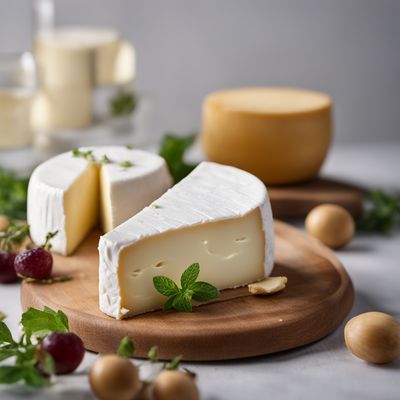
Ingredient
Soft - ripened cheese
Creamy Delights: Exploring the World of Soft-Ripened Cheese
Soft-ripened cheese, also known as bloomy rind cheese, is characterized by its soft and creamy texture. It is made by introducing specific molds, such as Penicillium candidum, during the cheese-making process. This results in a thin, edible white rind that encases the rich and luscious interior. The cheese ripens from the outside in, becoming increasingly soft and flavorful as it ages. The interior paste ranges from slightly firm to oozy, depending on the variety. Soft-ripened cheese can have a delicate, buttery flavor with hints of earthiness and mushroom notes. Its appearance is often pale ivory or yellow, with a velvety white rind that adds visual appeal to any cheese board.
Origins and history
Soft-ripened cheese has a rich history that dates back centuries. It is believed to have originated in France, particularly in the regions of Brie and Camembert. These iconic cheeses have become synonymous with soft-ripened cheese worldwide. The production techniques and traditions associated with soft-ripened cheese have been passed down through generations, resulting in a wide variety of regional specialties. Today, soft-ripened cheeses are produced in many countries, each with its own unique twist on this beloved cheese style.
Nutritional information
Soft-ripened cheese is a good source of protein and calcium. It also provides essential vitamins, such as vitamin A and vitamin B12. However, it is important to note that soft-ripened cheese is higher in fat and calories compared to some other cheese varieties.
Allergens
Soft-ripened cheese may contain milk, which can be a potential allergen for individuals with lactose intolerance or milk allergies.
How to select
When selecting soft-ripened cheese, look for a cheese that is plump and evenly shaped, with no visible cracks or bulges. The rind should be white and velvety, without any signs of discoloration or mold growth. To ensure optimal quality, choose cheese that is not overly soft or runny, as this may indicate overripeness.
Storage recommendations
Soft-ripened cheese should be stored in the refrigerator, ideally in its original packaging or wrapped in wax paper. It is important to keep it away from strong-smelling foods to prevent flavor absorption. To maintain its freshness and prevent excessive ripening, consume soft-ripened cheese within a few days of purchase.
How to produce
Soft-ripened cheese production requires specialized knowledge and equipment. It is best left to professional cheesemakers who have expertise in the cheese-making process, including the use of specific molds and aging techniques.
Preparation tips
Soft-ripened cheese is incredibly versatile and can be enjoyed in various ways. It can be spread on crackers or bread, melted into sauces or soups, or used as a topping for salads and pizzas. To enhance its flavors, bring the cheese to room temperature before serving. Soft-ripened cheese pairs well with fruits, such as pears or grapes, as well as with honey or nuts for a delightful cheese platter.
Substitutions
Soft-ripened cheese can be substituted with other creamy and mild cheeses, such as Camembert or triple cream Brie, to achieve a similar texture and flavor profile.
Culinary uses
Soft-ripened cheese is a staple in cheese boards and charcuterie platters, where it can be enjoyed on its own or paired with various accompaniments. It is also commonly used in gourmet sandwiches, quiches, and savory tarts to add a creamy and indulgent element. Additionally, soft-ripened cheese can be incorporated into pasta dishes, risottos, and gratins to elevate their richness and depth of flavor.
Availability
Soft-ripened cheese is commonly available in countries with a strong cheese-making tradition, such as France, Italy, the United States, and the Netherlands. It can also be found in specialty cheese shops or gourmet grocery stores worldwide.
More ingredients from this category

Soft-ripened washed-rind cheese (limburger type)
The Bold and Creamy Delight

Soft-ripened cheese with white and blue mould (cambozola type)
Cambozola: The Creamy Delight with a Mouldy Twist

Soft-ripened cheese veined with blue mould (blue bavarian, blue de graven type )
Velvety Blue Delight

Soft-ripened cheese with bloomy rind (white mould) (brie, camembert type)
Velvety Delight

Soft-ripened cheese with natural rind and other soft-ripened cheeses
Velvety Delights: Exploring Soft-Ripened Cheeses
Recipes using Soft - ripened cheese » Browse all

New York-Style Cheesecake
Elegant Twist: Nouvelle Cuisine Cheesecake

Sireki Stuffed Chicken Breast
Cheesy Delight: Sireki Stuffed Chicken Breast

Putian-style Gringas
Savory Putian Gringas: A Fusion of Mexican and Putian Flavors

Montenegrin-style Sweet Cheese Fritters
Savory Delights: Montenegrin Sweet Cheese Fritters

Kljukuša Reimagined: A Note by Note Culinary Delight
Harmonious Symphony of Flavors: Kljukuša Reinvented

Bosnian-Style Cheesecake
Sarajevo Delight: Bosnian-Style Cheesecake

Extremaduran-style Fatányerós
Savory Delight: Extremaduran Twist on Fatányerós

New York-Style Cheesecake
Dutch Delight Cheesecake

Cuban-Style Cheesecake
Havana Delight Cheesecake

New York-Style Cheesecake
Velvety Latvian Cheesecake Delight

New York-Style Cheesecake with a Middle Eastern Twist
Arabian Delight Cheesecake

Baked Pasta with Guangxi Flavors
Guangxi-inspired Baked Pasta Delight